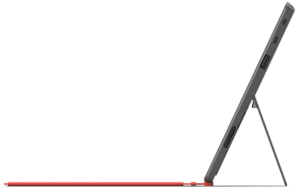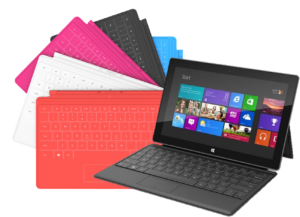What is Microsoft Surface? A tablet I want for business
 Last week, on October 25th, Microsoft launched their new operating system Windows 8 across the world. In addition to a new operating system, Microsoft launched the first version of “Microsoft Surface”. I’m very excited about this new type of device as it brings together entertainment and productivity in a form factor we haven’t experienced before. I’m not much of a gadget freak – I’m more interested in business productivity, but after seeing the webcast launch my first reaction was – where can I get one and when? Let me share a little bit more about Microsoft Surface and why it excites me from a productivity perspective.
Last week, on October 25th, Microsoft launched their new operating system Windows 8 across the world. In addition to a new operating system, Microsoft launched the first version of “Microsoft Surface”. I’m very excited about this new type of device as it brings together entertainment and productivity in a form factor we haven’t experienced before. I’m not much of a gadget freak – I’m more interested in business productivity, but after seeing the webcast launch my first reaction was – where can I get one and when? Let me share a little bit more about Microsoft Surface and why it excites me from a productivity perspective.
What is Microsoft Surface?
Microsoft Surface is an entirely new range of tablet devices innovated, designed and manufactured entirely by Microsoft. Even though Microsoft is predominately a software company, Microsoft has experience in producing hardware, perhaps the most well-known being Xbox. Why is it important to point out that Microsoft is making the hardware? Traditionally Microsoft follows a partner model where Microsoft develops the operating system and other vendors the hardware. The huge benefit of this is scalability and variability – the downside is the vulnerability. Microsoft can’t control the hardware. Designing and developing a device from beginning to end gives Microsoft full control of the product. This is the model that Apple follows, and even though it doesn’t scale like the partner model, it has proven to be very successful if the product is right.
 Personally, I was a bit confused about the name “Surface” for the new sleek, tablet devices when they were first introduced in June. The reason is that the name “Surface” was previously used for a product Microsoft introduced in 2007 which was a large table-like device with built-in cameras. Even though this product has lost its original name, it still remains in a newer version, now under the (not so exciting) name “Samsung SUR40 with Microsoft® PixelSense”.
Personally, I was a bit confused about the name “Surface” for the new sleek, tablet devices when they were first introduced in June. The reason is that the name “Surface” was previously used for a product Microsoft introduced in 2007 which was a large table-like device with built-in cameras. Even though this product has lost its original name, it still remains in a newer version, now under the (not so exciting) name “Samsung SUR40 with Microsoft® PixelSense”.
Two (very) different versions of Microsoft Surface
Microsoft has so far introduced two different versions of Microsoft Surface, one called “Surface with Windows 8 RT” and one called “Surface with Windows 8 Pro”. It’s only the RT version that is available in stores as of last week. The Pro version is “coming soon” according to the website as of today. Microsoft executive Steven Sinofsky said at the initial introduction in June that the Pro version would be released about 3 months after the RT version. The RT version runs on a so-called “ARM architecture” a different chipset technology than traditional Windows which runs on the Intel-platform. This means that applications that have been written for Windows don’t work on the Surface Windows RT tablet. You can only use the applications that are pre-installed or applications that you download from the Microsoft online store. For a full comparison of the different Surface editions, you can refer to the “Help me choose” web site.
A sleek design
 Microsoft Surface has a very lean and attractive design. The screen is 10.6 inches in diagonal (26.9 cm) which is slightly larger than an iPad which is 9.7 inches (25 cm). The RT version is 0.37 inches (0.94 cm) thin and weighs 1.5 lbs (680 g). The Pro version will be slightly thicker and heavier at 0.53 inches (1.3 cm) and 2 lbs (907 g), which is still a very sleek design. This is a device that fits perfectly into my handbag!
Microsoft Surface has a very lean and attractive design. The screen is 10.6 inches in diagonal (26.9 cm) which is slightly larger than an iPad which is 9.7 inches (25 cm). The RT version is 0.37 inches (0.94 cm) thin and weighs 1.5 lbs (680 g). The Pro version will be slightly thicker and heavier at 0.53 inches (1.3 cm) and 2 lbs (907 g), which is still a very sleek design. This is a device that fits perfectly into my handbag!
A tablet you can plug things in to
If you are a traditional PC user you won’t understand the excitement with a USB-port, but if you are an iPad user you know what I’m talking about. The Microsoft Surface has a full-size USB-port and a micro-SD slot. This means that you can easily copy files to and from the tablet, you can watch videos and images from your storage card and plug in USB-peripherals such as printers, mice, keyboards, etc. For me, this is a must when it comes to being productive and using a tablet for business.
Keyboards for fast typing
 Just like other tablets, Microsoft Surface has an on-screen keyboard. On-screen keyboards might be adequate for typing search terms in a browser, but it won’t do if you want to write a longer text. To address the need for better typing capabilities Microsoft has designed two keyboards for Microsoft Surface – Touch Cover and Type Cover. As the names suggest, these keyboards also act as covers for the tablet and they are attached to the tablet using a magnet.
Just like other tablets, Microsoft Surface has an on-screen keyboard. On-screen keyboards might be adequate for typing search terms in a browser, but it won’t do if you want to write a longer text. To address the need for better typing capabilities Microsoft has designed two keyboards for Microsoft Surface – Touch Cover and Type Cover. As the names suggest, these keyboards also act as covers for the tablet and they are attached to the tablet using a magnet.
The Touch Cover is 3.25 mm thin and weighs about 200 grams. It doesn’t have traditional keys, instead, the material is pressure sensitive so you just tap on the keyboard layout to write. The Touch cover comes in black, white, cyan (bright blue), magenta (dark pink) and red. Even though the Touch Cover enables you to write better than the on-screen keyboard, it still takes some getting used to and it’s not the ideal solution if you need to do a lot of typing.
The Type Cover, on the other hand, is a traditional keyboard that meets those needs. With its 6 mm it’s a bit thicker than the Touch Cover, but it still has a very sleek design.
A tablet I can use for business
I love my iPad – I wouldn’t want to be without it. But when I think about what it is used for it’s pretty limited – I surf the web, watch the news, check email, read books and my two-year-old son plays games on it. I never use it for business. When I travel I always bring my laptop with me. As I see it Microsoft Surface fills the need I have for a light-weight tablet for entertainment and work. I can write my blog articles using Microsoft Word, I can respond to email in Outlook, I can easily copy files to and from the Tablet and take notes in meetings or when brainstorming. The price tag for Microsoft Surface Windows 8 Pro still hasn’t been revealed, but I’m hoping it will be reasonable so that a lot of people can benefit from using it.
(If you have difficulties reading this article, you can access the full article in pdf here).

